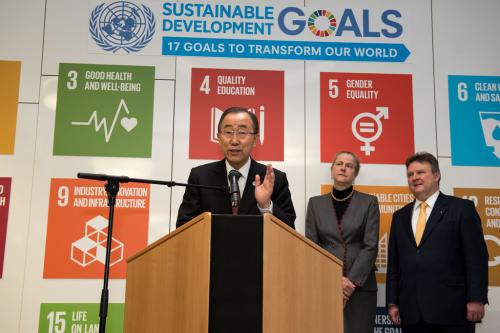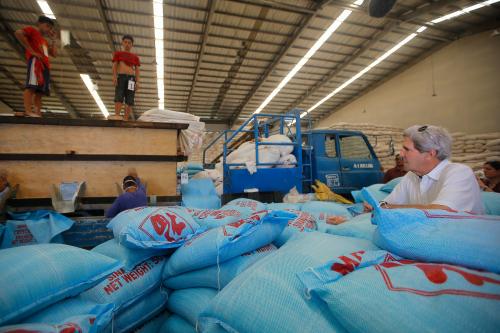Content from the Brookings Institution India Center is now archived. After seven years of an impactful partnership, as of September 11, 2020, Brookings India is now the Centre for Social and Economic Progress, an independent public policy institution based in India.
This article first appeared in Techonomy. The views are of the author(s).
Global society is at an unusual juncture. Even as historic crises and unmet societal needs deeply affect the human condition, many have unbounded enthusiasm for the transformative problem-solving potential of emerging technologies.
On one hand, these are the worst of times. We are confronted with unprecedented challenges. Critical indicators have been breaking records — for example, the rising levels of carbon dioxide in the air and the extent of human displacement — exacerbated by refugees fleeing conflict, drought or floods, and other calamities.
On the other hand, these are the best of times. Expectations of what can be accomplished with technological innovation and its impact are at an all-time high in some of the most influential quarters — from Silicon Valley to Wall Street and even in many government offices worldwide. Technology enthusiasts at the annual gatherings at Davos remain routinely enthusiastic about the possibilities of a “fourth industrial revolution” — a blurring of the lines between physical, digital, and biological innovations. The optimism of many business leaders remains undented even as increasing vulnerabilities have caused citizens worldwide to question their trust in the emerging technologies.
There is great trepidation about digital ecosystems right alongside great enthusiasm.
Concurrently, there is a growing acknowledgement that the traditional providers of public goods — governments, multilateral agencies, philanthropies and the social sector — cannot break through the magnitude of the problems to be solved without the direct engagement of the private sector. A natural question is: Why would the private sector have an interest?
There is, indeed, a business case for such private provision of public goods. Consider the following rationale: the annual costs of achieving the U.N. Sustainable Development Goals — a cumbersome but comprehensive framework for identifying the unmet needs of the planet and people that remain to be solved — are in the range of $3 trillion to $5 trillion (with the public sector chipping in about $1.4 trillion) annually. But the “new market value” that may be unlocked by businesses that embrace such goals is at least $12 trillion annually, according to estimates by the Business & Sustainable Development Commission, a group of global business leaders assembled to assess and advocate for the goals.
It makes sense when one considers the fact that the largest growth opportunities for business are in the developing world. While this broad cost-benefit analysis is attractive in the aggregate, it remains a challenge to translate it into action at the individual company level. Managers are risk-averse and are held responsible for near-term targets.
But as detailed in the Inclusion Inc. research conducted jointly by the Fletcher School at Tufts University, the Citi Foundation, and the Monitor Institute, forward-looking companies, including Unilever, Mastercard, Microsoft, Essilor, and Starbucks, among others, have stepped forward to take a long view.
Still, a widespread, systematic and meaningful set of actions across entire industries is lacking. This requires businesses to more broadly recognize the coincidence of commercial interests with the Sustainable Development Goals, but where their respective investments can have the deepest and widest impact.
Of the different levers that businesses could apply against the various opportunities in sustainable development, few are as powerful as those involving digital technology. Given its track record in upturning the status quo in so many different domains, technology offers a platform for numerous product and business model innovations to take on intractable problems. At the Fletcher School’s Institute for Business in the Global Context, which I direct, our Digital Planet research reveals some interesting patterns.
There is a divide between the “digital north” and the “digital south” — broadly corresponding to economically advanced and developing nations, respectively — in terms of different levels of adoption momentum, engagement and trust in all things digital. It is also becoming clear that the south will follow a different path from the north in many ways — how it applies technology to problems, in the willingness to trade data for services, and in how social media is used to get news and other forms of information.
Because technology is finding its way into so many aspects of human endeavor, it is no surprise that many major technology companies, for example SAP and Ericsson, have made the case that they are adapting their products to the digital south. Their solutions, they believe, can help make advances on most, if not all, of the 17 of the SDGs. Other companies, such as Google and Facebook, have taken on broad global projects involving attempts to connect every human anywhere to the internet. Microsoft has a “Cloud for Good” initiative. Others, such as Amazon, Netflix, and Chinese giants Alibaba and Tencent are eyeing a wide variety of markets across the digital south. Such companies are looking to invest now in order to reap the gains of growth in the future.
There is an additional motivation for those companies to direct their energies towards the provision of public goods, in both the digital north and the digital south. The industry faces a severe trust crisis — despite the growing reliance on its products worldwide. The trust issues revolve not just around security, privacy, or reliability of the information carried by digital media, but also around concerns about excessive market power and whether many of the technologies in development themselves might displace humans at work in the coming decades.
The nature of the concerns are different in the digital north and the digital south. For example, while the fake news concerns are largely associated with worries about foreign interventions in elections in the digital north, in many parts of the digital south, including Myanmar, Kenya, and India, fake news and rumors spread on digital media have had a severe human toll: They have led to deaths and persecution of entire communities. In both north and south, this has contributed to a breakdown of civil society and core institutions, but the outcomes have taken different forms.
This is a particularly opportune moment to engage key decision-makers, investors, and innovators in the digital industry to explore how technology can be harnessed for the biggest unmet needs of the planet and people — what might be called “smart” sustainable development — without adding to the mess.








Commentary
Op-edWho’s afraid of a digital planet?
September 6, 2018